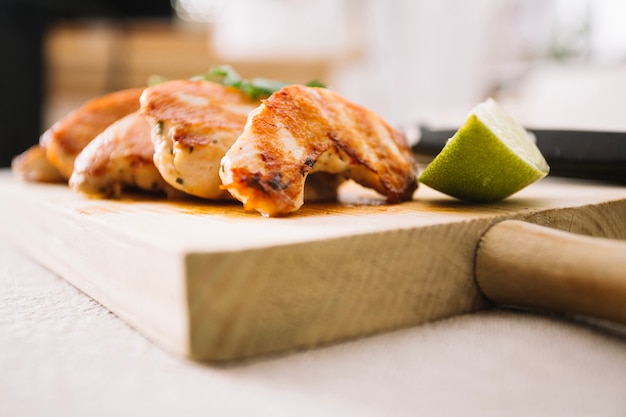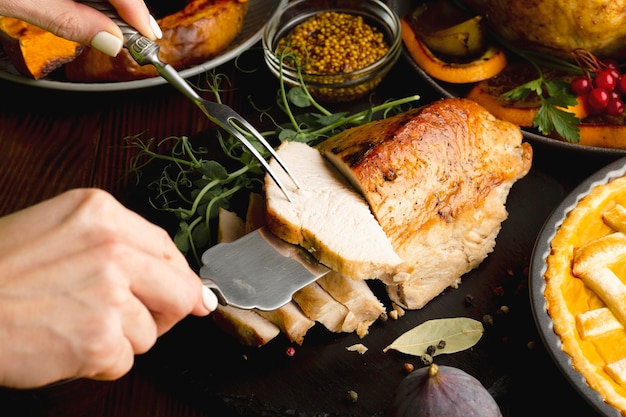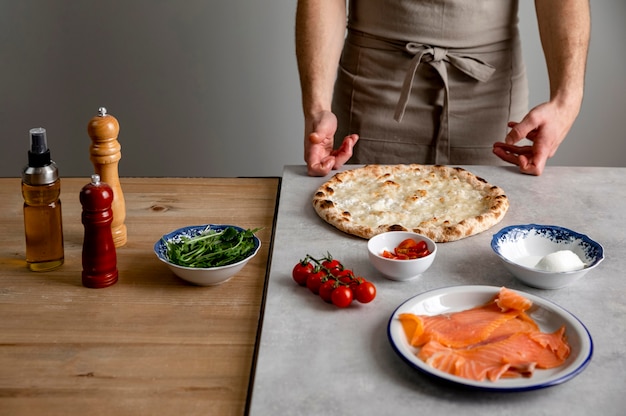Tilapia. It's one of those fish that sparks a strong reaction, isn't it? Some people adore it, others find it a bit bland. But I'm here to tell you, tilapia is a total champion when it comes to ease and versatility in the kitchen. It's a real lifesaver on those busy weeknights, and let's be honest, who doesn't love a bit of easy when it comes to cooking?
I've cooked tilapia in just about every way imaginable – pan-fried, grilled, even slow-cooked. But nothing quite beats good old oven-baked tilapia. It's so straightforward, yet the results are always incredible. I'm going to let you in on all my secrets, share some of my favourite recipes, and even point out a few things to avoid so you can create the perfect, flaky, moist tilapia every single time.
So grab a cuppa, get comfy, and let's get baking!
(Part 1) The Magic of 400 Degrees: Why It's the Sweet Spot for Tilapia

There's a lot of talk about oven temperatures when it comes to fish, and it can feel a little overwhelming. But trust me, 400 degrees Fahrenheit (204 degrees Celsius) is the secret ingredient for baking the perfect tilapia. It's the perfect balance – hot enough to cook the fish through quickly, ensuring it stays wonderfully moist, and preventing it from drying out. Plus, at this temperature, the skin gets deliciously crispy, which is a total game-changer for me. Come on, who doesn't love a bit of that crispy goodness?
Why High Heat is Your Friend
Here's the deal, folks. Lower temperatures can lead to overcooked, dry fish. You want that perfect balance – a juicy, flaky interior and a crisp, golden-brown exterior. And for tilapia, 400 degrees is that sweet spot.
Understanding Baking Time at 400 Degrees
The baking time for tilapia at 400 degrees will depend on the thickness of the fillets. A general guideline is 10-15 minutes, but it's always best to check for doneness with a fork. If the fish flakes easily, it's ready to go.
Think of it like this: If you're baking a cake, you wouldn't just throw the batter into a cold oven, would you? Same goes for our tilapia. It needs that initial burst of heat to get the baking process going correctly.
(Part 2) The Importance of Preheating Your Oven

Okay, this might seem obvious, but preheating your oven is absolutely crucial for achieving that perfect bake. It's like getting your oven all ready and excited to meet the tilapia. It creates a hot and even environment that ensures the fish cooks evenly and prevents it from sticking to the baking sheet.
Preheating Time for 400 Degrees
Most ovens take around 10-15 minutes to reach 400 degrees. So, pop that bad boy on and let it heat up while you're prepping your fish and getting your ingredients ready.
(Part 3) Preparing the Tilapia: Beyond Just a Rinse

So, you've got your tilapia fillets, and you're ready to bake. But hold your horses, there's a little more to prepping them than just a quick rinse.
Pat it Dry
One of the biggest mistakes people make is not patting their tilapia dry before baking. Any excess moisture can lead to soggy fish, which is a big no-no. So, take a few minutes to pat those fillets dry with paper towels. You want them to be nice and dry before hitting the oven.
Seasoning is Key
Now, this is where the fun part comes in. You can go wild with seasonings for your tilapia. A simple sprinkle of salt and pepper will do the trick, but I love experimenting with different flavours. Here are some of my personal favourites:
- Lemon and herbs: A squeeze of lemon juice and some fresh herbs like dill, parsley, or thyme add a bright and refreshing flavour. The combination is light and perfect for a summer meal.
- Garlic and paprika: A classic combination, garlic and paprika add a rich, earthy flavour to the tilapia. This option is great for a comforting, autumnal meal.
- Cajun spices: For a bit of a kick, try a blend of paprika, cayenne pepper, garlic powder, onion powder, and black pepper. This recipe is perfect for a warm and spicy meal that will leave you feeling satisfied.
Get creative and experiment to find your own flavour combinations. You might even find a new favourite!
(Part 4) Choosing the Right Baking Sheet
Your baking sheet can make a big difference in the final result. You don't want your tilapia sticking to the sheet, which can lead to frustration and a messy cleanup. So, choose wisely!
The Importance of Non-Stick
Go for a non-stick baking sheet, preferably one with a rim. It'll make your life so much easier. You can easily slide the baked tilapia off the sheet and it won't stick.
Lining for Extra Protection
For extra insurance, you can always line your non-stick baking sheet with parchment paper or foil. This will provide an extra layer of protection and make cleanup a breeze.
Avoid Overcrowding
Don't cram your baking sheet with tilapia. Give each fillet enough space to breathe. This will help them cook evenly and prevent them from steaming instead of baking.
(Part 5) The Ultimate Baking Time Guide
Okay, so we've preheated the oven, prepped our fish, and have our baking sheet ready. Now it's time to talk baking time. Remember, this is just a guideline, and the actual baking time will depend on the thickness of your tilapia fillets.
The Basics
At 400 degrees, tilapia fillets typically take:
| Thickness | Baking Time |
|---|---|
| Thin (1/2 inch) | 10-12 minutes |
| Medium (3/4 inch) | 12-15 minutes |
| Thick (1 inch) | 15-18 minutes |
Checking for Doneness
The best way to check if your tilapia is cooked through is by using a fork. Gently insert it into the thickest part of the fillet. If the fish flakes easily and is no longer translucent, it's ready to go.
If you're unsure, it's always better to err on the side of caution and cook it for a few more minutes. Overcooked tilapia is dry, so avoid that at all costs!
(Part 6) Recipes to Elevate Your Tilapia Game
Now, let's dive into some delicious recipes that will make your tilapia game strong. These are some of my personal favourites, and they're all easy to make, perfect for a weeknight dinner.
1. Lemon-Herb Tilapia with Roasted Vegetables
This is a classic and refreshing dish that's always a crowd-pleaser. It's a simple combination of flavours that really lets the tilapia shine.
Ingredients:
- 4 tilapia fillets (about 6 ounces each)
- 1 tablespoon olive oil
- 1 lemon, thinly sliced
- 1/4 cup chopped fresh herbs (such as dill, parsley, and thyme)
- Salt and pepper to taste
- 1 pound mixed vegetables (such as broccoli, carrots, bell peppers)
Instructions:
- Preheat your oven to 400 degrees.
- Pat the tilapia fillets dry with paper towels.
- Drizzle the tilapia with olive oil and season with salt and pepper.
- Place the tilapia fillets on a baking sheet lined with parchment paper.
- Top each fillet with a few lemon slices and herbs.
- Toss the vegetables with olive oil, salt, and pepper.
- Spread the vegetables around the tilapia fillets on the baking sheet.
- Bake for 12-15 minutes, or until the tilapia is cooked through and the vegetables are tender.
This dish is a great example of how simple and delicious tilapia can be. The lemon and herbs add a bright, refreshing flavour to the fish, while the roasted vegetables provide a satisfying and nutritious side. It's the perfect dish for a light and healthy meal.
2. Garlic-Parmesan Tilapia with Creamy Lemon Sauce
If you're looking for something a bit more indulgent, this is the recipe for you. The creamy lemon sauce adds a touch of richness and elegance to the dish.
Ingredients:
- 4 tilapia fillets (about 6 ounces each)
- 1 tablespoon olive oil
- 2 cloves garlic, minced
- 1/4 cup grated Parmesan cheese
- 1/4 cup chopped fresh parsley
- Salt and pepper to taste
- 1/4 cup butter
- 1/4 cup lemon juice
- 1/4 cup heavy cream
Instructions:
- Preheat your oven to 400 degrees.
- Pat the tilapia fillets dry with paper towels.
- In a small bowl, combine the olive oil, garlic, Parmesan cheese, parsley, salt, and pepper.
- Spread this mixture over the tilapia fillets.
- Place the tilapia fillets on a baking sheet lined with parchment paper.
- Bake for 12-15 minutes, or until the tilapia is cooked through.
- While the tilapia is baking, make the sauce. Melt the butter in a saucepan over medium heat.
- Add the lemon juice and heavy cream and simmer for a few minutes, or until the sauce thickens slightly.
- Pour the sauce over the baked tilapia and serve immediately.
This recipe is a great option for a more luxurious meal. The creamy lemon sauce complements the fish perfectly, while the Parmesan cheese adds a salty and nutty flavour. It's a dish that's sure to impress your guests.
3. Spicy Cajun Tilapia with Mango Salsa
For a taste of the tropics, try this spicy Cajun tilapia with a refreshing mango salsa. It's a great combination of flavours and textures.
Ingredients:
- 4 tilapia fillets (about 6 ounces each)
- 1 tablespoon olive oil
- 1 teaspoon Cajun seasoning
- Salt and pepper to taste
- 1 ripe mango, diced
- 1/2 red onion, diced
- 1/4 cup chopped fresh cilantro
- 2 tablespoons lime juice
- 1 teaspoon honey
Instructions:
- Preheat your oven to 400 degrees.
- Pat the tilapia fillets dry with paper towels.
- Drizzle the tilapia with olive oil and season with Cajun seasoning, salt, and pepper.
- Place the tilapia fillets on a baking sheet lined with parchment paper.
- Bake for 12-15 minutes, or until the tilapia is cooked through.
- While the tilapia is baking, make the mango salsa. In a bowl, combine the mango, red onion, cilantro, lime juice, and honey.
- Serve the baked tilapia topped with the mango salsa.
This recipe is a fun and exciting way to enjoy tilapia. The spicy Cajun seasoning adds a kick to the fish, while the mango salsa provides a cool and refreshing contrast. It's a perfect dish for a summer barbecue or a light and flavorful meal.
(Part 7) Common Mistakes to Avoid
Now that we've got the basics down, let's talk about some common mistakes to avoid when baking tilapia at 400 degrees.
1. Overcrowding the Baking Sheet
I know it's tempting to cram as many fillets as possible onto the baking sheet, but trust me, it's not worth it. Overcrowding leads to steaming instead of baking, which results in soggy, mushy fish.
Think of it like this: if you're trying to bake a batch of cookies, you wouldn't squeeze them all together on the baking sheet. You'd give them space to spread out and bake evenly. It's the same principle with tilapia.
2. Not Patting the Fish Dry
As I mentioned earlier, any excess moisture can lead to a soggy mess. So, take a few minutes to pat those fillets dry before putting them in the oven.
You want to make sure the surface of the fish is as dry as possible. This will help the skin crisp up nicely and prevent the fish from steaming.
3. Under-Seasoning
Tilapia can be a bit bland on its own, so don't be shy with the seasonings. Experiment with different flavours and find what you like.
Think of seasonings as the flavour enhancers of your dish. They bring out the best in the tilapia and create a truly delicious meal.
4. Overcooking the Fish
Overcooked tilapia is dry and tough. So, pay attention to the baking time and use a fork to check for doneness.
It's better to err on the side of caution and slightly undercook the fish. You can always pop it back in the oven for a few more minutes if needed.
5. Not Checking the Oven Temperature
Always make sure your oven is preheated to 400 degrees. It's the key to ensuring your tilapia cooks evenly and gets that beautiful golden-brown crust.
A preheated oven helps create a consistent temperature throughout the baking process. This ensures your fish cooks evenly and prevents it from sticking to the baking sheet.
(Part 8) Beyond Baking: Storing and Reheating
You've cooked up a beautiful batch of baked tilapia, and now you're wondering about storage and reheating. Here's the lowdown.
Storing Leftovers
Let your baked tilapia cool completely before storing it in an airtight container in the refrigerator. It should last for up to 3 days.
Remember, proper storage is key to maintaining the quality of your tilapia. It's best to let it cool completely before putting it in the refrigerator, as this prevents condensation from forming and making the fish soggy.
Reheating Tips
For the best results, reheat your tilapia in the oven at 350 degrees for about 10 minutes, or until heated through. You can also reheat it in the microwave, but it may lose some of its moisture.
Oven reheating is generally the best option for maintaining the texture and flavour of the tilapia. If you're short on time, the microwave is a viable option, but be prepared for it to be a bit drier.
(Part 9) FAQs: Your Tilapia Baking Questions Answered
1. Can I Bake Tilapia with the Skin On?
Absolutely! Baking tilapia with the skin on helps to keep it moist and adds a delicious crispy texture. Just make sure to score the skin with a few slits to prevent it from curling up during baking.
Scoring the skin helps to release steam and prevents it from curling up. This allows the fish to cook evenly and results in crispy, delicious skin.
2. How Do I Know if Tilapia is Done?
The best way to check for doneness is by using a fork. If the fish flakes easily and is no longer translucent, it's ready to go.
The flaky texture and opaque colour are good indicators that the tilapia is cooked through and ready to be enjoyed.
3. Can I Add Other Ingredients to My Tilapia Bake?
Yes, you can! Try adding sliced tomatoes, onions, peppers, or mushrooms to your tilapia bake for extra flavour and texture.
These ingredients will add a burst of flavour and texture to your tilapia bake. You can also experiment with other vegetables and herbs to find your favourite combinations.
4. What If My Tilapia is Overcooked?
If your tilapia is overcooked and dry, there's not much you can do to salvage it. However, you can try adding a bit of lemon juice or butter to help moisten it up.
While overcooked tilapia can be a bit dry, it's still edible. Adding some lemon juice or butter will help to add some moisture and flavour to the fish.
5. What is the Best Way to Season Tilapia?
There is no one "best" way to season tilapia. Experiment with different flavours and find what you like. Some popular options include lemon and herbs, garlic and paprika, Cajun spices, and simply salt and pepper.
The best way to season tilapia is really a matter of personal preference. Experiment with different flavours and find what you enjoy. Don't be afraid to get creative and try new combinations.
I hope you found this guide helpful! Now go forth and bake some delicious tilapia. Happy cooking!
Everyone is watching

Corn on the Cob: The Ultimate Guide to Perfectly Cooked Ears
Healthy MealsAh, corn on the cob. Just the name evokes images of sunny days, barbecues, and that sweet, juicy flavour that ...

Perfect Pork Roast Oven Cooking Time: A Guide to Delicious Results
Healthy MealsThere's something truly satisfying about a perfectly roasted pork. The aroma alone is enough to make your mout...

Ham Cooking Time: How Long to Bake, Smoke, or Boil a Delicious Ham
Healthy MealsAh, ham. It's a classic, isn't it? A real crowd-pleaser, especially around holidays. And when done right, it'...

Scallops: The Ultimate Guide to Perfect Cooking
Healthy MealsAh, scallops. Those delicate, sweet, and utterly delicious morsels of the sea. They hold a special place in my...

Spaghetti Squash: The Ultimate Guide to Cooking and Serving
Healthy MealsRemember that time you saw spaghetti squash at the supermarket, looking all bumpy and strange, and thought, "W...
